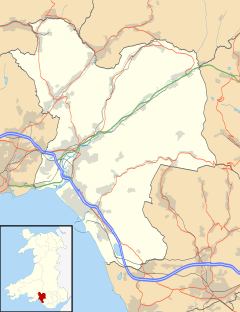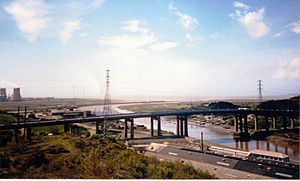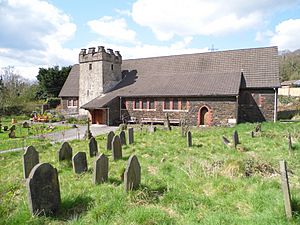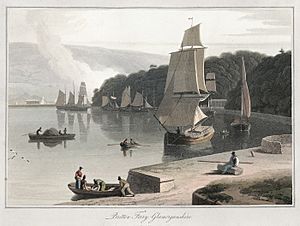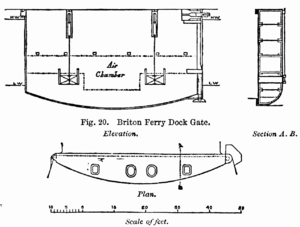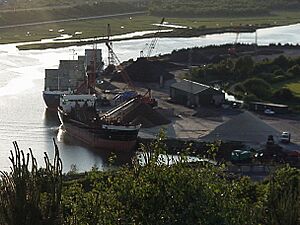Briton Ferry facts for kids
Quick facts for kids Briton Ferry
|
|
|---|---|
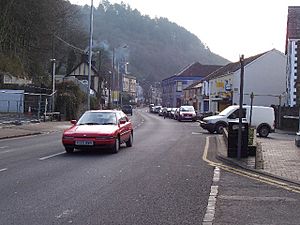 |
|
| Population | 5,911 (2909 East ward and 3002 West ward) (2 Wards 2011) |
| OS grid reference | SS735945 |
| Principal area |
|
| Ceremonial county | |
| Country | Wales |
| Sovereign state | United Kingdom |
| Post town | NEATH |
| Postcode district | SA11 |
| Dialling code | 01639 |
| Police | South Wales |
| Fire | Mid and West Wales |
| Ambulance | Welsh |
| EU Parliament | Wales |
| UK Parliament |
|
Briton Ferry (Welsh: Llansawel) is a town and community in Neath Port Talbot, Wales. Its Welsh name, Llansawel, might mean a church (llan) protected from the wind (awel). Another idea is that Sawel comes from Saul, an earlier name for St Paul, who some say landed here. An older Welsh name, Rhyd y Brython, means "Briton's Ferry." The Normans called the river crossing La Brittonne. In 1540, Leland called it Britanne Fery.
Contents
About Briton Ferry
Briton Ferry is located where the River Neath meets Swansea Bay. It was the first place to cross the river along an old Roman road that followed the coast of South Wales. A Roman milestone was found nearby. The old ferry boat crossing was about 2 miles (3.2 km) from a bridge over the River Neath in Neath. At very low tides, people could even walk across the river using stepping stones.
Briton Ferry is built on ground that has many cracks and faults, close to where the River Neath flows into the sea. The river crossing today includes two bridges. These bridges carry the M4 motorway and the A483 road over the river.
You can find remains of ancient Iron Age hill forts on the hills around Briton Ferry. They are called Buarth-y-Gaer and Gaer Fawr. A very old stone from the Stone Age (Neolithic period) is located at Cwrt Sart school. A sign next to it says, "When removed, it will speak but once to reveal its secret, and then remain silent forever." There's also a place called Giant's Grave, which might have a cromlech (an ancient stone tomb). A Bronze Age axe was found at Crymlyn Burrows.
The town was once part of the Briton Ferry Estate. This land belonged to Margam Abbey before it was passed to the Mansel, Villiers, and Vernon families (who were Earls of Jersey). In the early 17th century, the Price family owned it. Later, Louisa Barbara Mansell married George Venables Vernon in 1757. She left the estate to her godson, George, Earl of Jersey. He made the estate smaller and more modern to keep it running well.
Briton Ferry's Industrial Past
Early Industries
Briton Ferry has a long history of industry. Simple forges existed here as early as the 1660s, using local coal. The town's location by the sea helped its industries grow. In 1840, a large area of land was leased for industrial use. Houses were built for workers, but many were later taken down because they were not safe.
In the late 1700s and early 1800s, ships at Giant's Grave loaded coal from the Neath Valley to export. They also brought in iron ore and limestone. The Neath and Tennant Canal was finished in 1797. It was the second canal in Glamorgan, running 14 miles (22.53 km) to Briton Ferry.
In 1841, the Neath Abbey Iron Co planned an ironworks. With the growth of railways, Isambard Kingdom Brunel designed the Briton Ferry Dock. It opened in 1861 to handle coal and other goods. Ironworks opened in 1846, and copperworks in 1849 and 1853. By the 1860s, the town started making tinplate. Steel-making began here at the end of the 1800s.
Later Industries
More factories came to Briton Ferry, like Vernon, Gwalia, Wern, Baglan Bay Tinplate, and Whitford Sheet Works. They got their materials from the Albion and Briton Ferry Steelworks. Companies like Taylor's Foundry and Thos. W. Ward helped these industries. They were built near the River Neath and the South Wales Railway. Other railways, such as the Neath and Brecon Railway, also came to the area.
Briton Ferry Floating Dock
In the 1850s, the Briton Ferry Floating Dock Company was formed. They bought land from the Earl of Jersey to build the docks. When it opened in 1861, the dock had an outer tidal basin and an inner floating dock. The inner dock was 5.3 hectares (13.1 acres) and kept its water level with a special gate. This gate was 56 feet (17 m) wide. The unique floating gate was designed by Marc Isambard Brunel, the father of Isambard Kingdom Brunel. After Brunel's death in 1859, Robert Brereton took over as engineer.
The company later went out of business. The Great Western Railway took over the docks until they closed in 1959. Much of the inner dock area has now been built on.
In 2000, the dock walls and lock gate were given a special heritage listing. This was because they are important parts of Brunel's historic docks. The dock is also a protected Ancient Monument.
A project started in 2005 to save and restore Brunel's historic site. A tower that was part of the dock complex was fixed up. This tower was an accumulator tower for the hydraulic system that moved the dock gate and cranes. William Armstrong designed this system. In 2010, a plaque was put up to celebrate Armstrong's 200th birthday. The outer part of the dock could still be used by fishing boats and yachts.
During World War II, ships like HMS Bermuda were taken apart at Giant's Grave. This area is upstream from the floating dock. Two local songwriters, Huw Pudner and Chris Hastings, wrote a song called "Giants Grave" about the ship-breaking industry. This song was even in a film about Briton Ferry's history.
The wharves (docks) at Briton Ferry are now run by Neath Port Authority. Giant's Wharf handles steel, scrap, coal, and machine parts. Ironworks Wharf handles minerals like sand and cement. Together, they handle about 200 ships each year.
Louis Gustave Mouchel
In 1875, a French engineer named Louis Gustave Mouchel came to Briton Ferry. He became very successful. His company was important for bringing ferroconcrete (also called reinforced concrete) to Britain. A building in nearby Swansea was said to be the first fully ferroconcrete building in the UK.
Briton Ferry was so important for trade with France that Mouchel became the French Consular Agent for the area from 1879 until he died.
Housing in Briton Ferry
In the 1800s, most houses were built by local builders, sometimes for industries or railways. You can still see these types of houses in areas like Giant’s Grave. The town started building its own public housing in the late 1800s and continued after World War II. In the 1950s, tall apartment buildings were tried because there wasn't much land, but they weren't very successful. Later, these tall buildings and some of the oldest houses near the docks were taken down. New public housing was built in their place.
Changes in Industry
Many industries in Briton Ferry closed down in the second half of the 1900s. In 1947, steel and tinplate companies joined together to form the Steel Company of Wales. By 1953, only the Albion Steelworks was left in Briton Ferry.
The Albion Steelworks closed in 1978 and was taken down within a year. Then, the ship-breaking and steel supply company, Thos. W. Ward, closed in 1983. This company had operated from 1906 to 1979, taking apart many merchant and navy ships.
Other local companies also closed in the early 2000s. BP Chemicals opened a plant at nearby Baglan Bay in 1963. It grew to be one of Europe's biggest chemical sites. But by 2004, it closed completely. BP's oil refinery at Llandarcy closed four years later. The Metal Box Company announced its closure in 2015.
The Industrial Revolution brought a lot of growth to Briton Ferry, with ironworks, steelworks, and tinplate production. Most of this production lasted until the 1970s. As industries began to shrink in 1951, parts of the old estate were sold off to different property and housing companies.
Modern Briton Ferry
Today, few of the original industries remain in Briton Ferry. However, new industries have started in nearby communities like Baglan. For example, Intertissue, a paper company at Baglan Energy Park, employs many people. This park aims to create thousands of jobs in the future. It even has a large solar energy farm. Amazon opened a huge warehouse in Jersey Marine in 2008.
Getting Around
Trains
Railways were very important for Briton Ferry's industries. The town still has a train station, Briton Ferry railway station. It's near a key railway junction. Transport for Wales runs regional trains to Swansea, West Wales, Cardiff, and Manchester. First Great Western trains to London do not stop here. Usually, there's a train every two hours in each direction.
Buses
Briton Ferry has many local bus services run by First Cymru. These buses help people get to shops, colleges, and hospitals in the Neath-Port Talbot area. There are also express buses to Bridgend, Maesteg, and Swansea.
Roads
The M4 motorway and the A483 road go around the town. This helps reduce traffic on the A474, an old Roman road that runs through Briton Ferry.
First Road Crossing
The first major road bridge over the river was built between 1949 and 1955. It was one of the first big road bridges built in Britain after World War II. It has two parts: one crosses the River Neath, and the other crosses the old dock area and the main railway line.
Second Road Crossing
The second road crossing was finished in 1994. It carries the M4 motorway across the River Neath. This bridge completed the last 10 km (6.2 mi) of the M4 motorway between Newport and west Wales. Building it was very difficult because of the many industries, flood-prone areas, and the navigable River Neath in its path.
Fun Things to See and Do
At the south end of town, you can see a sculpture by John Mills called The Crossing. It represents the town's history with industry and the sea, especially its important bridges and river crossing.
Jersey Park is a very well-kept public park that opened in 1925. The land was given by the Earl of Jersey in 1908. The park still has its original design with formal and informal areas, plus sports facilities. It has many different types of trees and shrubs. Jersey Park is listed as a Grade II historic park in Wales.
Rhoddfa Clarke is the name of a sloped part of the old South Wales Mineral Railway. The lower, flat part of this railway is now Jersey Park. Coal wagons used to be pulled by ropes here, bringing coal from Glyncorrwg to Briton Ferry dock. Above the busy streets of Briton Ferry, the park and incline offer a peaceful escape to Craig y Darren Woods. This old woodland has many footpaths with great views of the town and Swansea Bay.
Sports Clubs
- Briton Ferry Llansawel A.F.C. (football)
- Briton Ferry RFC (rugby)
- Briton Ferry Steel Cricket Club (cricket)
- Briton Ferry Town Cricket Club (cricket)
Famous People from Briton Ferry
- Kenneth Crosby (1904–1998), a linguist and missionary, was born here.
- Sir Francis Avery Jones (1910–1998), a Welsh doctor, was born here.
- Harry Parr-Davies (1914–1955), a musician and composer, was born here.
- Mavis Nicholson (1930-2022), a journalist and broadcaster, grew up here.
- David Pickering (born 1960), a Welsh rugby personality, was born here.
- Alf Shea (1898–1969), a Welsh cricketer, was born here.
Nearby Places
- Crymlyn Burrows
- Llandarcy
- Neath
- Port Talbot
- Baglan
- Baglan Bay
Twin Town
Briton Ferry is twinned with Ouagadougou, in Burkina Faso.


